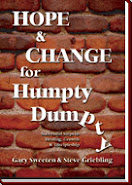
Stained Glass Religion
Joel 2:28-29 was one of the favorite passages of scripture quoted by preachers and teachers during the Jesus Movement.
Joel 2: 28 "And afterward,
I will pour out my Spirit on all people.
Your sons and daughters will prophesy,
your old men will dream dreams,
your young men will see visions.
29 Even on my servants, both men and women,
I will pour out my Spirit in those days.
Why was this such an important passage to the young men and women of the Sixties and Seventies? I suppose the answer to that question is somewhat obvious to anyone who reads it. In fact, I think this verse by an obscure prophet of whom most of us had never heard was the guiding plan for almost everything that has happened since the Jesus Movement.
So, before I post my ideas about the top ten changes let me post thoughts about the top ten paradigms that controlled religious thought before the Holy Spirit's great Revival in the second half of the 2oth Century.
1. The primary focus was on "religion" and "religions" that were tightly organized and controlled by a hierarchy, traditions and cultural agreements. The "Mainline Churches/Denominations" were large, dominant and the epitome of what people expected from God. (They were called "mainline" after the railroad of the same name that ran along Philadelphia's richest and most powerful neighborhoods.) Religion was divided between Jews and Christians and the Christians between Protestant and Catholic, ignoring less prominent groups.
2. Ecumenical Movements focused on dialogues among and between the various Protestant and Catholic denominations, sometimes inviting Jews. They were led by erudite members of the clergy who ruled the National and World Council of Churches.
3. Social action and the "Social Gospel" was preached and taught and mostly meant that the NCC and WCC urged the Federal and State Governments to pass legislation designed to help the poor. Some groups also had food pantries and supported soup kitchens.
4. There was a strict demarcation between clergy and the laity. Clergy were well trained and well spoken graduates of advanced education who were ordained to preach, pray, baptize and do the spiritual work of God. They were paternalistic and kindly to the unenlightened laity. The laity did secular work and supported the clergy by attendance and financial contributions.
5. The laity were not expected to be knowledgeable of the Bible or implement any spiritual practices at home, work or in the world. Religion was a passive spectator sport mostly designed for women and children.
6. Religious services were done by the professionals and watched by the laity. Clergy wore special garb and used special language and had special music that separated the church from the people and the world. The Holy Spirit was rarely mentioned except at baptism. His gifts were restricted to the clergy if mentioned at all.
7. There was little leisure time and few people went on vacations or understood what was happening overseas or over the mountains in America. People worked hard and after stopping were often physically or emotionally able to be active in community, church of family life.
8. There was a strict separation of races, ethnic groups, classes and cultures in most churches. This separation was strongly reinforced by language, dress, musical styles and traditions. Traditions and practices stayed the same from region to region with similar hymn books, readings, the liturgical year and in some cases nation to nation and language to language.
9. The style of communication emphasized one active speaker to many passive listeners.
10. Few people had ever traveled outside their city and state nor did they know people of a different religion, ethnicity or race.
Wow, did these assumptions ever change as a result of the Jesus Movement. If you have lived through them yourself, you can understand why some people have been overwhelmed by all the trauma.
My next posts will cover the TOP TEN CHANGES since the Jesus Revival.








No comments:
Post a Comment